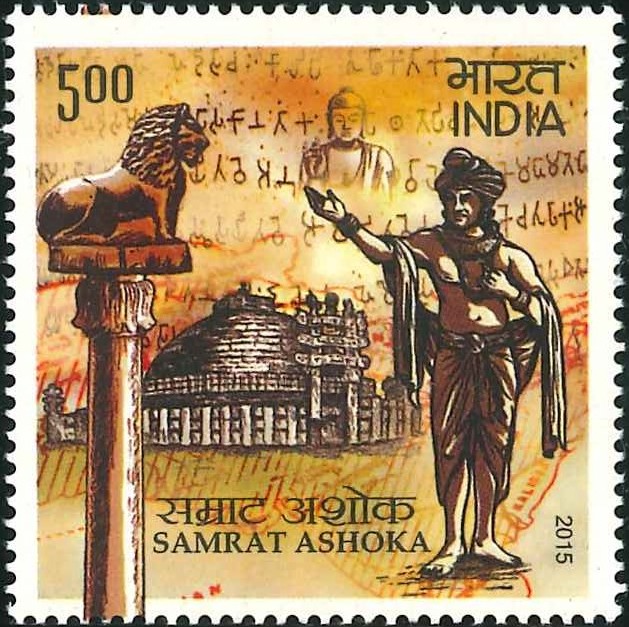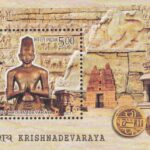
Samrat Ashoka
A commemorative postage stamp on the 3rd Mauryan Emperor, Asoka the Great :
 Issued by India
Issued by India
Issued on Aug 24, 2015
Issued for : The Department of Posts is please to release a commemorative postage stamp on Samrat Ashoka.
Credits :
Stamp : Kamleshwar Singh
FDC/Cancellation : Alka Sharma
Type : Stamp, Mint Condition
Colour : Multi Colour
Denomination : 500 Paise
Stamps Printed : 500 Paise
Printing Process : Wet Offset
Printer : Security Printing Press, Hyderabad
Name : Ashoka Maurya
Born on 304 BCE at Pataliputra, Magadha, India [now in Patna, Bihar]
Died on 232 BCE at Pataliputra, Magadha, India [now in Patna, Bihar]
About :
- Ashoka the Great (304 B.C.E. – 232 B.C.E.), also known as Asoka, was the third ruler of the Maurya Empire who ruled from 273 B.C.E. to 232 B.C.E. He was the grandson of Chandra Gupta Maurya and son of Bindusara. After a number of military conquests, Ashoka reigned over most of South Asia and beyond, from present day Afghanistan in the north to Bengal in the east, and as far south as Mysore. An early supporter of Buddhism, Ashoka established monuments marking several significant sites in the life of Shakyamuni Buddha, and according to Buddhist tradition was closely involved in the preservation and transmission of Buddhism.
- King Ashoka has come to be regarded as one of the most exemplary rulers in world history. The British historian H.G. Wells has written; “Amidst the tens of thousands of names of monarchs that crowd the columns of history ….. the name of Asoka shines, and shines almost alone, a star.” Although there were references in Buddhist literature to Ashoka, definitive historical records of his reign were lacking till the nineteenth century when there came to light a large number of edicts, in India, Nepal, Pakistan and Afghanistan. These edicts, inscribed on rocks and pillars, proclaim Ashoka’s reforms and policies and promulgate his advice to his subjects. Ashoka was the first ruler who inscribed his messages to his subjects and officials on stone surfaces – natural rocks as well as polished pillars. He used the inscriptions to proclaim what he understood to be dhamma.
- In the beginning, Ashoka is believed to have used military strength to expand his empire. During his expansion of the Mauryan Empire, Ashoka led a war against a state named Kalinga (present day Orissa) with the goal of annexing its territory, something that his grandfather had already attempted to do. The conflict took place around 261 BCE and it is considered one of the most brutal and bloodiest wars in history. Even though the people from Kalinga defended themselves courageously, Ashoka’s military strength was far beyond Kalinga’s.
- On witnessing the extent of destruction in Kalinga after the war, Ashoka issued an edict expressing his regret for the suffering inflicted in Kalinga. He assured that he would renounce war and embrace the propagation of dhamma.
- For Ashoka, dhamma was an ancient tradition which was essentially a code of ethical behaviour and the benefits thereof, which appeared to be his attempt to universalize a code focused on social ethics and on the accommodation of diverse views. His formulations of dhamma were intended to influence the conduct of his people in relation to each other, and included practice of respect for elders, treating slaves and servants kindly and respect for religions and traditions other than one’s own. The empire included a spectrum of societies where different categories were variously organized. The emphasis on harmonious social relations between the different people was repeated on many occasions. Besides, general values such as not injuring humans and animals, being forgiving, treating all creatures with compassion, observing piety and adhering to the truth were also emphasized.
- Ashoka was a statesman in the context of inheriting and sustaining an empire in a particular historical period, as well as a person with a strong commitment to changing society through the propagation of social ethics. He advocated tolerance, and non-violence as official policy and this makes him an unusual ruler. He built roads, dug wells and built rest houses. Besides, he also arranged for medical treatment for both human beings and animals.
- Ashoka sought the advancement of the essentials of all sects and believed that this was only possible if each treated the other with respect. He believed that in honouring the views of others one is honouring one’s own sect. He instituted a body of dhamma–mahamattas concerned with the general welfare of his subjects. The dhamma-mahamattas went from place to place spreading the message of dhamma. Ashoka also sent messengers to spread these ideas to other lands.
- Ashoka’s edicts are to be found scattered in more than thirty places throughout India, Nepal, Pakistan and Afghanistan. Most of these edicts are written in Brahmi script. Ashoka’s edicts, which comprise the earliest decipherable corpus of written documents from India, have survived throughout the centuries because they are written on rocks and stone pillars with animal capitals. These pillars in particular are testimony to the technological and artistic genius of ancient Indian civilization. Averaging between forty and fifty feet in height, and weighing up to fifty tons each, the few capitals that survive are widely recognized as masterpieces of Indian art. Both the pillars and the capitals exhibit a remarkable mirror-like polish that have survived despite centuries of exposure to the elements. Some, like the Lumbini pillar, mark the Buddha’s birthplace, while its inscriptions commemorate Ashoka’s pilgrimage to that place. Others are to be found in or near important population centres so that their edicts could be read by as many people as possible.
- Text : Based on the material available on internet.








I have a FD cancellation from New Delhi GPO on First day cover dated 20/08/15. Will you kind enough to explain this cancellation please.
[…] that was built during the Mauryan period. Originally commissioned in the third century B.C. by Emperor Ashok, this huge hemispherical dome with a height of 54.0 ft consists of a central chamber where the […]
[…] Watermark : All over multiple ‘Lion Capital of Asoka‘ […]
[…] Buddhism in East Pakistan would appear to go back to Asoka, the Mauryan Emperor, as certain stupas there, according to Hiuen Tsang, had been founded by that […]
[…] The metal craft of India, which attained the standard of a fine art as early as from Harappan period, has a glorious past. Indian artisans knew the art of metal working since 3000 B.C. The beautiful figurine of the dancing girl belonging to the Indus valley civilization indicates the high level of workmanship attained by earlier craftsmen. The other high points reached by the craftsmen in the field of metalworking are bronze sculptures belonging to the Chola rulers and the iron pillar at Mehrauli, in Delhi, which was made during the time of King Ashoka. […]
[…] grain granite has been heightened by a fine gloss through burnishing, which equals to the polished Asokan figures of 3rd Century […]
[…] to live in harmony with each other. Long ago the Buddha taught us this lesson. From the days of Ashoka, 2300 years ago, this aspect of our thought has been repeatedly declared and practised. In our own […]
[…] seal of the High Court bears the device and impression of the Asoka Capital with the ‘gopuram‘, a common feature of temples in the South, in its background […]
[…] Watermark : All over multiple ‘Lion Capital of Asoka‘ […]
[…] Watermark : All over multiple ‘Lion Capital of Asoka‘ […]
[…] Watermark : All-over multiple ‘Lion Capital of Asoka‘ […]
[…] sandstone throne, Vajrasana which marks Buddha‘s seat of meditation. It is ascribed to Asoka, who as one of his edicts proclaims, undertook pilgrimage to Sambodhi. Other remnants include a […]
[…] cross swords symbolising the profession of arms over which is super imposed the Dharma Chakra of Ashoka. Grey and red colours of the crest denote resilience and supreme sacrifice. Many alumni of OTA […]
[…] Bodhgaya : The stamp on Bodhgaya depicts the giant Bodhi Tree where Prince Siddharth gained enlightenment. Bodhgaya has also the famous Mahabodhi Temple with a soaring spire. Its walls are covered with scenes depicting various aspects of Buddhism. The temple is said to stand at the site of the original 3rd Century B.C. temple built by Emperor Ashoka. […]
[…] National Emblem of India is an adaptation of the Lion Capital of Ashoka at Sarnath which is still preserved in the Varanasi Sarnath Museum in India. It was approved by the […]
[…] The ‘Bodhi Vriksha’ at Deekshabhoomi of Bodh Gaya is a sacred fig (Pipal) tree. This Bodhi Tree is a sapling of the same Bodhi tree under which Gautam Buddha attained enlightenment. This sapling of the Bodhi Tree was brought from Anuradhapuram in Sri Lanka. The Bodhi tree at Anuradhapuram is said to be planted from the sapling of original Bodhi Tree by Sanghmitra, the daughter of Emperor Ashoka. […]
[…] of the entrance to the Durbar Hall stands the Rampurva Bull capital, which dates back to the Asokan period. The central colonnade is flanked by twelve more pillars shorter in height and placed at a […]
[…] green at the bottom. A navy blue coloured Dharma Chakra or “Wheel of the Law”, also called Ashoka Chakra, with 24 equally spaced spokes is placed in the centre of the white band. This Wheel has […]
[…] : 1½ a : Asokan Capital, 3½ a : National Flag, 12 a : Modern […]
[…] Watermark : All over multiple “Lion Capital of Asoka“ […]